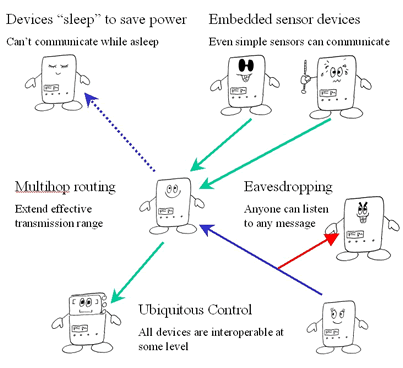
|
|
||||||||
Low Power Ad-hoc Wireless Networks
The Piconet project is working towards developing an office of the future where a number of electronic devices communicate without human intervention. Throught the use of low power, low range radio transmissions, Piconet equipped devices can discover that they are in proximity, enquire about each other's capabilities and communicate together to accomplish joint tasks.

The hardware and protocols are designed for use by a huge range of devices, from simple sensors through to workstations. For example, a portable computer might make use of Piconet to communicate with a cellular telephone, GPS system, or to interrogate a nearby printer - all without the intervention of the user. A Piconet beacon in a meeting room might ask all Piconet-enabled devices nearby such as watches, telephones and notebooks, to keep silent while a meeting is in progress. A Piconet node kept in a briefcase could gather information and perform simple tasks between home, car and office - updating files and ringing alarms as necessary.
All Piconet nodes use the same radio frequency (418MHz) and protocols so that any devices can potentially communicate. Access to nodes can be controlled by their programming and the range of the radio system is deliberately limited to a few metres so that it operates on a human scale. If devices need to communicate, they need simply to be gathered together.
The Piconet hardware is designed to be small, low power and low cost. The eventual aim is to integrate the processor, modem and radio onto a single chip so that the whole system can be combined with a coin cell power source and last for a few years in the simplest applications. To this end, a parallel research effort is investigating how asynchronous logic can help to reduce power consumption, eliminate clock induced radio interference and power up rapidly when required.